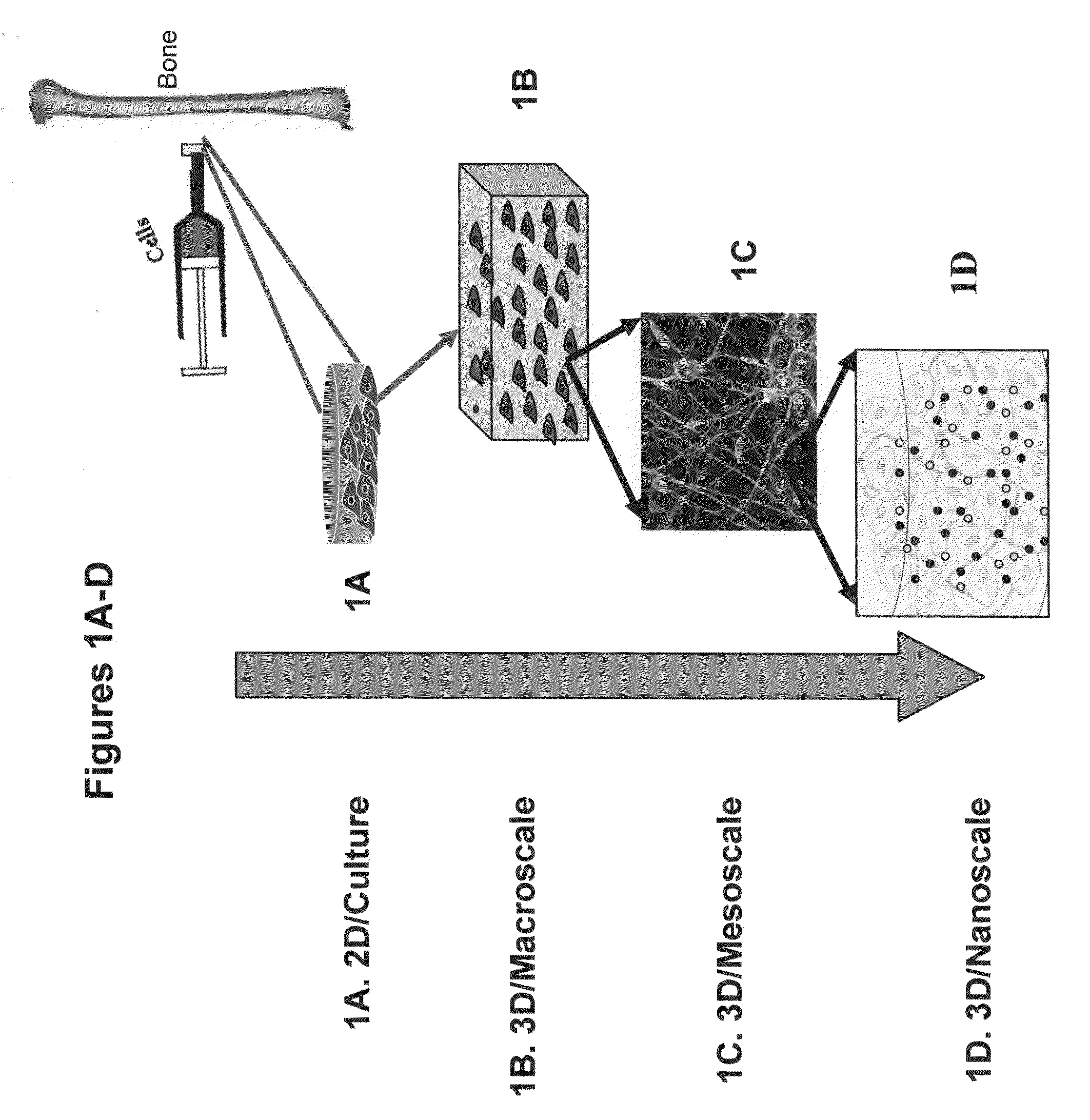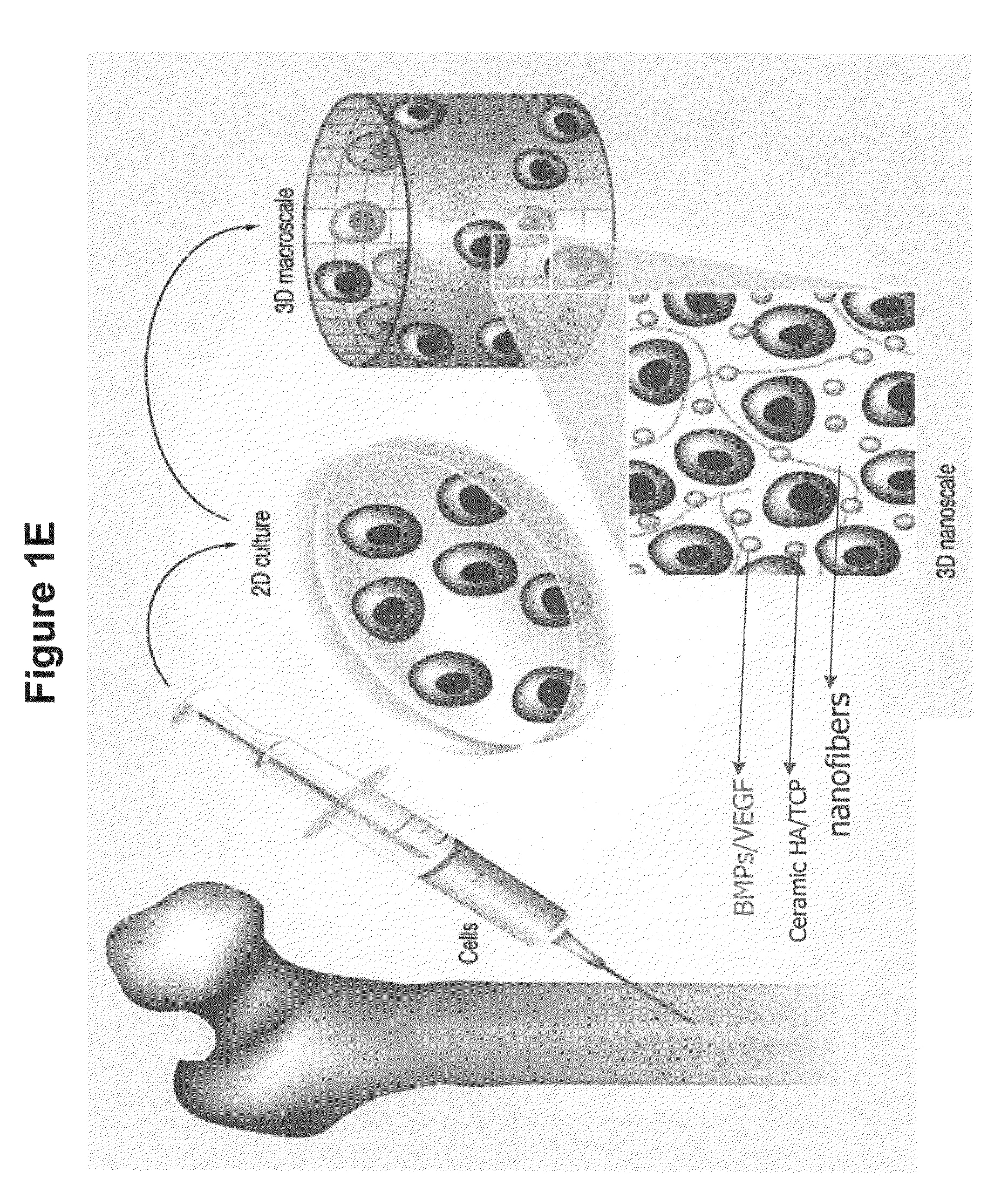Electrospun Scaffolds And Methods Of Generating And Using Same
- Summary
- Abstract
- Description
- Claims
- Application Information
AI Technical Summary
Benefits of technology
Problems solved by technology
Method used
Image
Examples
example 1
Generation of PCL Electrospun Scaffolds
[0175]Materials and Experimental Procedures
[0176]Electrospinning of Scaffolds
[0177]Poly (e-caprolactone) (PCL), a biodegradable polyester, with an average molecular weight of 80 kDa (Aldrich, USA) was dissolved in chloroform to obtain 10% wt. solution. The polymer solution was delivered at a constant flow rate to a metal capillary connected to a high voltage (13 kV). A fluid jet was ejected from the capillary. As the jet accelerated toward a grounded collector, the solvent evaporated and charged polymer fiber was deposited on a collector in the form of a non-woven scaffold. Hydroxylapatite (HA) particles (about 0.5 μm to 8 μm in diameter), dispersed in aqueous solution, were spread during the deposition process through a pneumatic setup located beyond the spinning apparatus (FIG. 2A).
[0178]The non-woven scaffold was cut in round shapes (0.5 mm) to fit a single well of a 96 well plate, sterilized (with oxygen plasma and antibiotics), washed (wit...
example 2
Generation of PCL / Gelatin Electrospun Scaffolds, Analysis and In Vivo Use
[0188]Materials and Experimental Procedures
[0189]Electrospinning of Scaffolds
[0190]PCL (approximately 80 kDa, Aldrich, USA) and acid Gelatin (Nitta Gelatin, Japan) were dissolved together (at a 1:1 ratio) in fluorinated alcohol of 2,2,2-trifluoroethanol (TFE) to give 9% and 12% solutions (w / v). The 9% solution was extruded from a 5 ml syringe connected to a hypodermic needle (bore size 0.6 mm; flow rate 3 ml / hr). The strength of the electrostatic field was 0.8 KV / cm. The electrospun nanofibers were deposited onto a grounded collector in the form of a non-woven sheet. Hydroxylapatite (HA) particles (about 0.5 μm to 8 μm in diameter), dispersed in aqueous solution, were spread during the deposition process through a pneumatic setup located beyond the spinning apparatus.
[0191]The end stage product size was 35×35×1.6 mm which was further cut into circular shapes (8 mm diameter) to fit into 24 well tissue culture pl...
example 3
Generation of Scaffolds for Connective Tissue Regeneration
[0218]Bone marrow derived MSCs will be selected in culture for their chondrogenic lineage using chondrogenic markers (such as alcian blue staining and collagen type II immunohistochemistry). These cells will be seeded in the different electrospun scaffolds (as explained in detail in Example 2 hereinabove) and will be examined for their potential to form cartilage. Formation of cartilage will be examined in vivo in ectopi subcutaneous animal models and in joint cartilage defect.
PUM
| Property | Measurement | Unit |
|---|---|---|
| Pore size | aaaaa | aaaaa |
| Diameter | aaaaa | aaaaa |
| Diameter | aaaaa | aaaaa |
Abstract
Description
Claims
Application Information
 Login to View More
Login to View More - R&D
- Intellectual Property
- Life Sciences
- Materials
- Tech Scout
- Unparalleled Data Quality
- Higher Quality Content
- 60% Fewer Hallucinations
Browse by: Latest US Patents, China's latest patents, Technical Efficacy Thesaurus, Application Domain, Technology Topic, Popular Technical Reports.
© 2025 PatSnap. All rights reserved.Legal|Privacy policy|Modern Slavery Act Transparency Statement|Sitemap|About US| Contact US: help@patsnap.com



